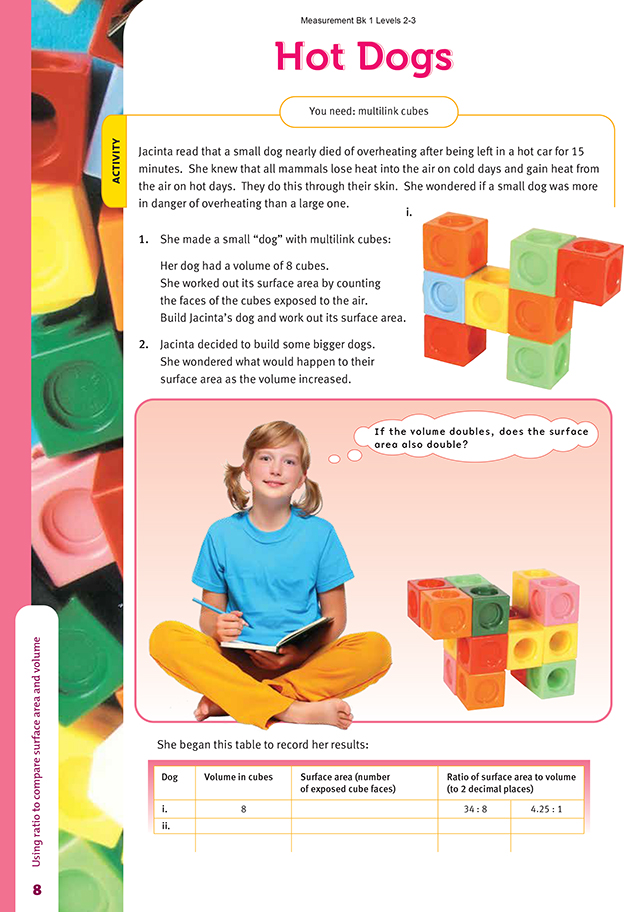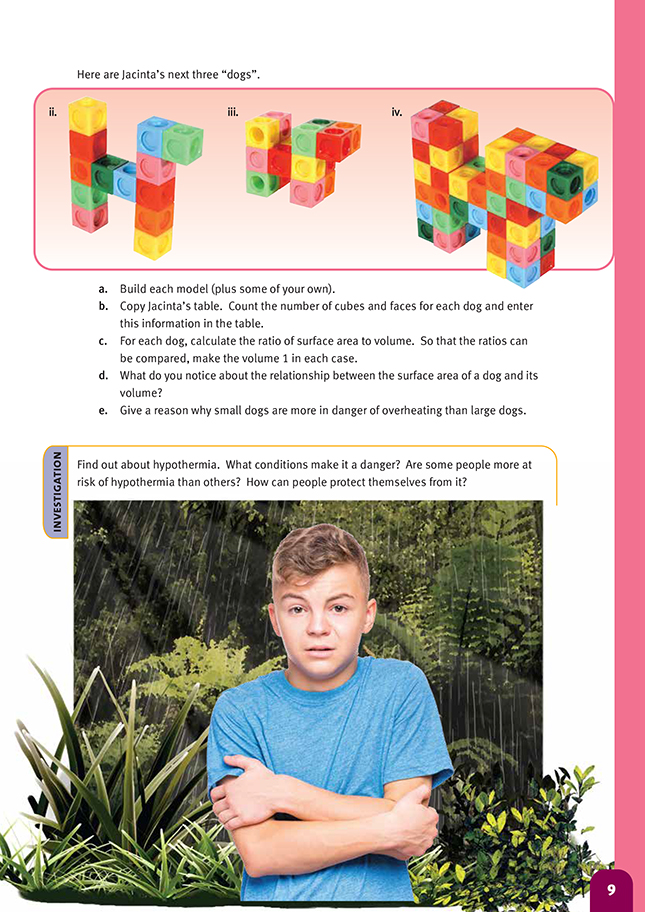This is a level 5 measurement strand activity from the Figure It Out series. It also has an achievement objective from the Level 5 Number strategies and knowledge substrand.
A PDF of the student activity is included.
Click on the image to enlarge it. Click again to close. Download PDF (377 KB)
use ratios to compare surface area and volume
FIO, Level 4+, Measurement, Book Two, Hot Dogs, pages 6-7
multilink cubes
In this activity, the students investigate the relationship between body size and surface area, using ratio. According to the suggested learning experiences for Number, students working at level 5 could be:
- exploring the use of ratio in everyday contexts
- developing meaning for ratio by comparing two like quantities
- investigating equivalent ratios
- recording ratios as a/b and a : b.
They will have all of these experiences as they work through this activity.
When doing questions 1 and 2, the students need to make sure that they count all the faces. They may find that the most systematic way of doing this is to consider each of the 6 possible views in turn (left, right, up, down, front, and back). They then put the numbers in a table and calculate the ratio of surface area to volume. For ease of comparison, they are asked to put the ratio in the form x : 1 (as in Fat in Foods, pages 4-5 of the students' book).
The students may have trouble seeing how to get from 34 : 8 to 4.25 : 1. To achieve this, they must divide both sides of the ratio by 8 (because 8 ÷ 8 = 1). This division makes use of the principle of equivalent ratios, which says that 2 : 3 = 4 : 6 = 18 : 27 = 1 : 1.5 = 200 : 300, and so on. This is the principle of equivalent fractions, slightly disguised. As well as helping your students work with these ratios, you may also need to help them interpret the meaning of the ratios they have calculated.
In question 2d-e, the students discuss the relationship between surface area and volume. They should be able to see that as the volume increases, so does the surface area, though not in a fixed ratio (because the shape of dogs varies greatly). This means that a small dog has a proportionally greater area of skin through which to gain (or lose) heat and is therefore more at the mercy of external conditions. Compare the vulnerability of a human baby.
Investigation
Hypothermia is the result of excessive heat loss through the skin, the reverse of the overheating problem that is the focus of questions 1 and 2. Hypothermia is often the cause of death in water accidents, rather than drowning (think of the Titanic). It is also a threat for unprepared trampers and climbers in the New Zealand outdoors. The last activity in this book, Chilling Out (page 24 of the students' book), is also relevant here.
Information about hypothermia can be found on the Internet, including these sites:
Cross-curricular links
Health and Physical Education
This activity could form part of a unit on hypothermia or safety in the outdoors.
Achievement Objectives
- access and use information to make and action safe choices in a range of contexts (Personal Health and Physical Development, level 4)
- investigate and practise safety procedures and strategies to minimise risk and to manage risk situations (Personal Health and Physical Development, level 5)
Science
This activity could be used in conjunction with a unit based around Building Science Concepts Book 46, Keeping Warm and Book 47, Insulation.
Achievement Objective
- investigate and describe structural, physiological, and behavioural adaptations which ensure the survival of animals and flowering plants in their environment, e.g., the organ systems which animals use to locate, catch (or harvest), eat, digest, transport, and use food; territoriality; social behaviour; photosynthesis, osmosis; transpiration (Making Sense of the Living World, level 5)
Answers to Activity
1. Practical activity. The total surface area is 34 squares (square units).
2. a. Practical activity
b.-c.
d. As body size increases, the ratio of surface area (skin) to volume decreases.
e. A small dog has proportionally more surface area (skin) than a large dog, so it loses or gains heat more rapidly and is less able to cope with extremes.
Investigation
Results will vary. Hypothermia is a loss of body heat, which leads to death if not stopped in time.


